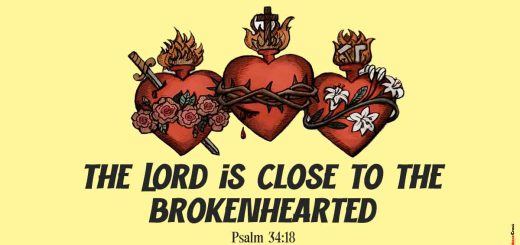15th Sunday in Ordinary Time Reflection

The Good Samaritan by Vasily Ivanovich Surikov 1864
This is my body, broken for you…
The abused becomes the abuser in a spiral of retaliation and anger that continues as we are beset on our journey, robbed, beaten and left naked and bleeding on the road; here is Christ’s body.
The mother’s body broken for us in the process of birthing; here is Christ’s body.
In the new-born baby, the window of original innocence and the grace that has the power to turn our hearts from hardened selfishness to sacrificial love; here is Christ’s body.
In the community of the marginalised, the Untouchables, the rejected, the LGBT and the persecuted; here is Christ’s body.
In the foreigner, the exile and the refugees feared and imprisoned; here is Christ’s body.
In the prostitute, the illegal immigrant and the destitute; here is Christ’s body.
In the Levite and the priest, teacher and administrator of legal precedent and justice who have become prisoners of their own purity codes of exclusion; here is Christ’s body.
In the eye of the Trinity lies the human heart of Jesus, broken and given for Love; here is Christ’s body.
Our Mother Earth with rivers poisoned, the oceans stagnant with waste, the forest home burning; here is Christ’s body.
The priest and the Levites were called to represent the people before God. Because of God’s holiness and purity, they were to be without physical defects, less than 50 years of age and consecrated by ritual cleansing rites that cleansed both sin and ritual impurity. They were to wear clothes of white linen and forbidden contact with a menstruating, impure or divorced woman. They were forbidden any contact with the dead or to show signs of mourning.
These purity codes divided everything into either clean or unclean; animals, people, and land divided into three categories to teach ethnic separation from the Gentiles. Animals that could be sacrificed were “holy”; wild game and fish that could be eaten but not sacrificed were “clean”; animals that could be neither eaten nor sacrificed were “unclean.”
This separation parallels that of people; where the same defects disqualify both priests and animals: priests (holy), ordinary Israelites (clean), and Gentiles (unclean). With space, there is the tabernacle (holy), the land (clean), and the nations (unclean).
Sexual acts also made one unclean. Bodily discharges, blood for women and semen for men, represented a temporary loss of strength and life and movement toward death. Because decaying corpses discharged, so natural bodily discharges were reminders of sin and death. Physical imperfections representing a movement from “life” toward “death” moved a person ritually away from God who was associated with life.
Love Above Ritual
Jesus did not allow these laws of purity to keep him from touching lepers, the sick and the lame, the dead as well as ritually and morally unclean woman considered sinful. His presence in Samaria was already a breach of the purity code. Jesus turned water, in jars for ritual purification, into wine.
Jesus condemned those who placed ritual above love. He rebuked those who, for ceremonial purity, cleanse the outside of the cup but do not practice inward moral purity or love. Yet Jesus would not condemn the woman caught in adultery. As Jesus is about to leave his disciples, he promises them the Helper who will show the people how incorrect they are about sin, about being right with God, and about judgement.
For some, sin and purification are a commercial commodity based on the Babylonian understanding of recompense for debts incurred. For some biblical ethnic separation has become an ideology. For some the old law of purification and separation becomes a safety net for the trap of pathological fear, insecurity, and doubt.
It is in the experiences of the great mystics that we see another way of understanding sin, justification and judgement. For Julian of Norwich, we are the dwelling city of God as we are also incarnations of God’s Son.
The phenomenon of sin is qualified as pain and isolation, as having no essence, as delusion and ignorance, as clashes of intentions and disregard of the context. The cause of suffering is the lack of knowledge, lack of proper perception, missing of one’s own identity and essence, inability to recognise and enjoy the presence of goodness as the fundament of reality.
The sinful consciousness is the innocently fragmented, isolated, perspectivistic, and variously conditioned consciousness, experiencing its own multiple contradictory intentions within itself and in relation to perceived world and other living beings; fragmentation, separation and isolation.
Here there is no wrath of God to be found, but sheer life of goodness which constantly creates, nourishes and permeates all known and unknown being.
For Thomas Merton sin which has its roots in the false self as the illusion of freedom in refusing to be what we are created to be as images of God. For him the secret of our identity is hidden in the Love and Mercy of God; finding God, we find our true self in God.
Sin robs us of the truth of who we are and robs us of our humanity. To regain the truth of our existence and our being which is submerged in the Trinity of love, compassion and boundless mercy, we are called to turn away from the lie of sin.
The Sin of Classification
The sin of classification is not the observing of basic differences, or in the preference of one ideology to another. The problem comes when I use someone’s classification as my reason for loving them (or not), rather than their humanity. This is convenient for me, since using their humanity as a reason to love them would mean I had to love everyone.
If one has to be pleasing to me, comforting, reassuring, before I can love them, then I cannot truly love them . . . If a person has to be a Jew or a Christian before I can love them, then I cannot love them. If they have to be black or white before I can love them, then I cannot love them. If they have to belong to my political party or social group before I can love them, if they have to wear my kind of uniform, then my love is no longer love because it is not free: it is dictated by something outside myself. It is dominated by an appetite other than love.
I love not the person but their classification, and in that event I love them not as a person, but as a thing. I love their label which confirms me in attachment to my own label. But in this case, I do not even love myself. I value myself not for what I am, but for my label, my classification. In this way I remain at the mercy of forces outside myself, and those who seem to me to be neighbours are indeed strangers for I am first of all a stranger to myself. – Merton’s discussion of “The Good Samaritan”
- The Church Year and Advent - December 1, 2024
- Easter Sunday Reflection: The Way – Love Overcomes Violence & Death - March 29, 2024
- Palm Sunday Reflection: Re-Espousing And Anointing - March 22, 2024





